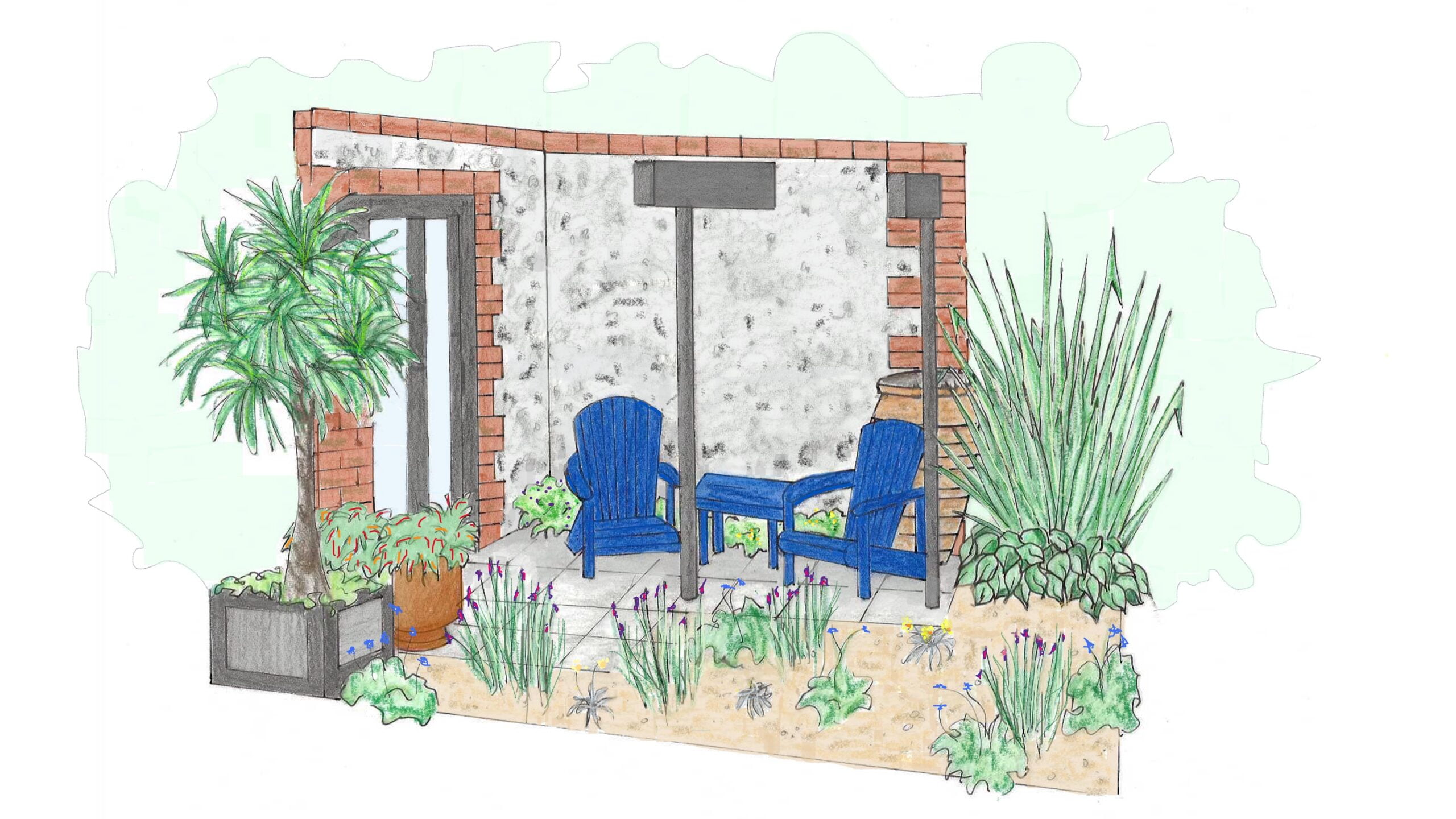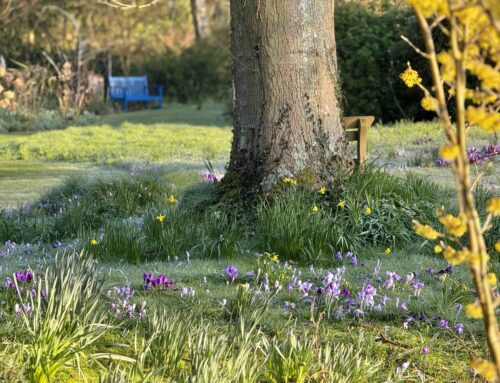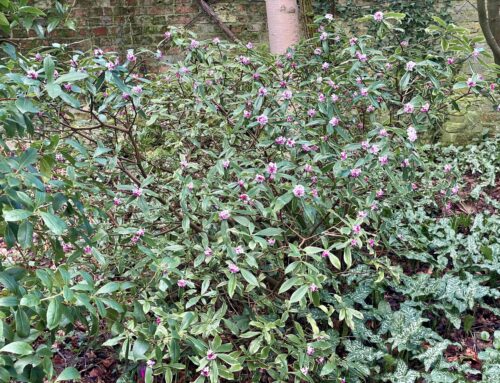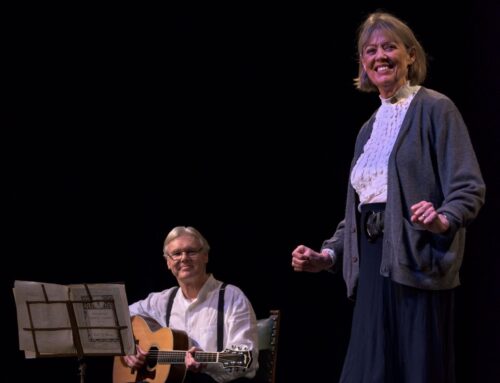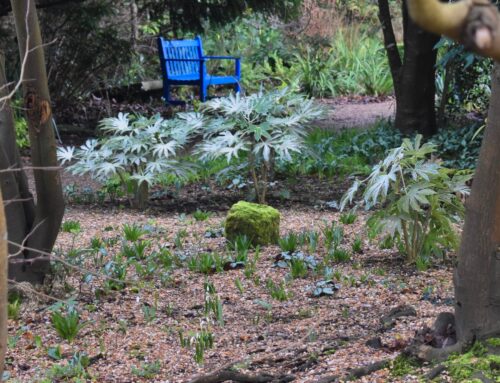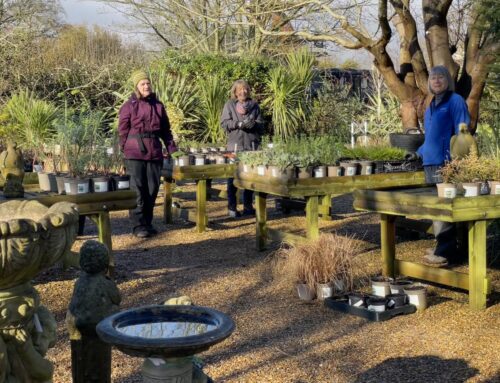PRESS RELEASE
3 June 2024
DENMANS GARDEN TO PRESENT JOHN BROOKES’ PRIVATE ‘ROOM OUTSIDE’ AT HAMPTON COURT PALACE GARDEN FESTIVAL
Denmans Garden, the award-winning contemporary garden at the foot of the South Downs in West Sussex, will make its Feature Garden debut at Hampton Court Palace Garden Festival next month, as the RHS shines the spotlight on its Partner Gardens.
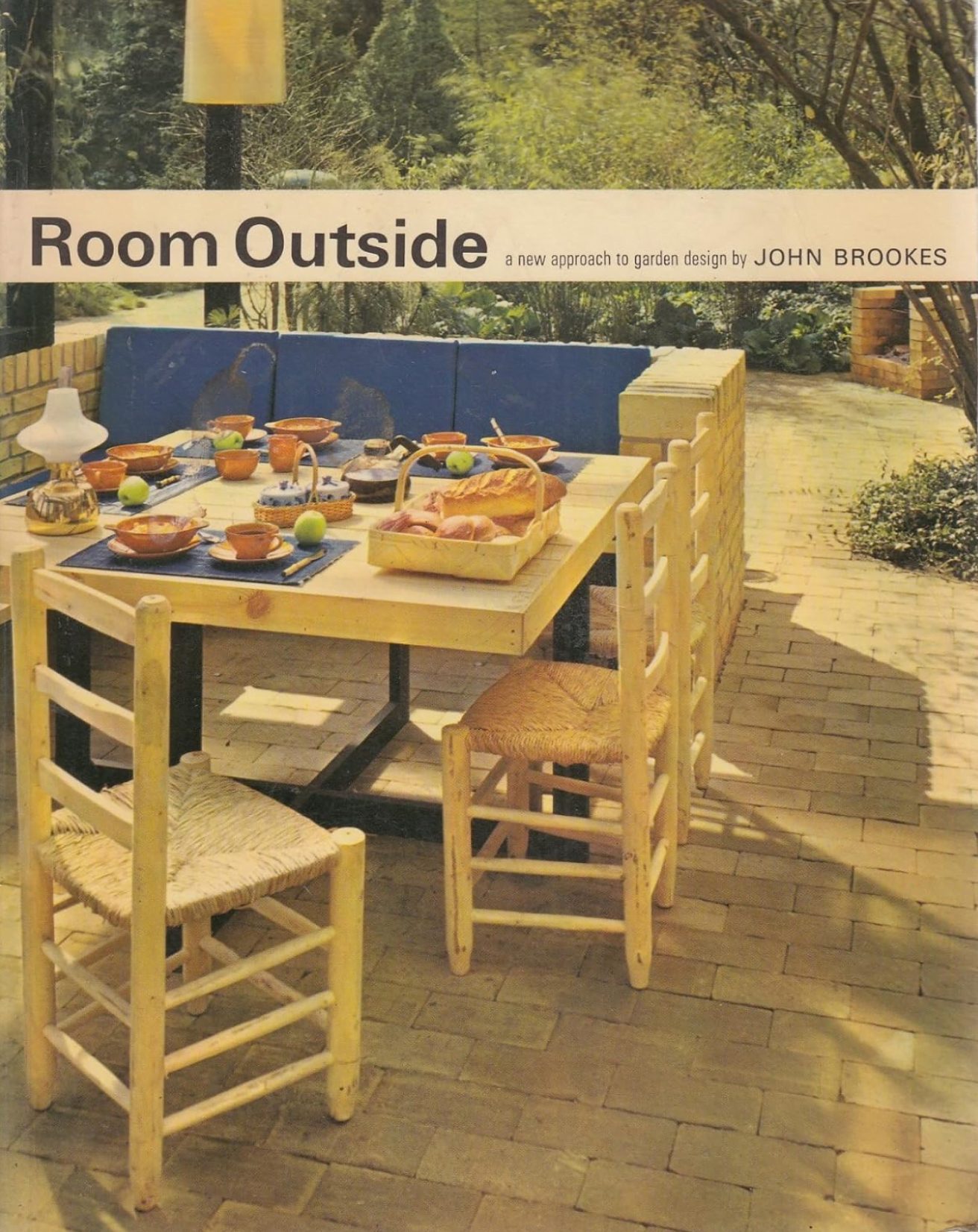
John Brookes first book, Room Outside, helped transform how British garden owners designed and used their gardens.
John Brookes MBE (1933-2018) revolutionised garden design beginning with his 1962 Chelsea Flower Show Garden which depicted a living space associated with an imaginary townhouse rather than a garden showcasing plants. A ‘room outside’ stylistically linked to the surrounding architecture, it was stylish, affordable and low maintenance. He popularised this then-novel concept in lectures and his seminal book Room Outside (Thames & Hudson, 1969).
Named after his book, Denmans Garden: Room Outside, one of two RHS Partner Garden Feature Gardens at the festival, represents Brookes’ own ‘room outside’, which he created outside his studio and home at the award-winning Denmans Garden in West Sussex where he lived from 1980 until his death in 2018. Reminding us of his trailblazing and enduring relevance, it features a terrace, gravel garden, and Brookes’ trademark pergola and blue chairs, and reflects his conviction that the garden should be an extension of the home, a living space tailored to the people who used it.
The Feature Garden also showcases the combined ethos of Denmans Garden’s two creators, Brookes and gravel garden pioneer and horticulturist Joyce Robinson (1903-1996). The garden, RHS Regional Partner Garden of the Year in 2021 and 2023, is a fusion of accessible contemporary design and sustainable horticultural diversity which draws visitors from around the world.
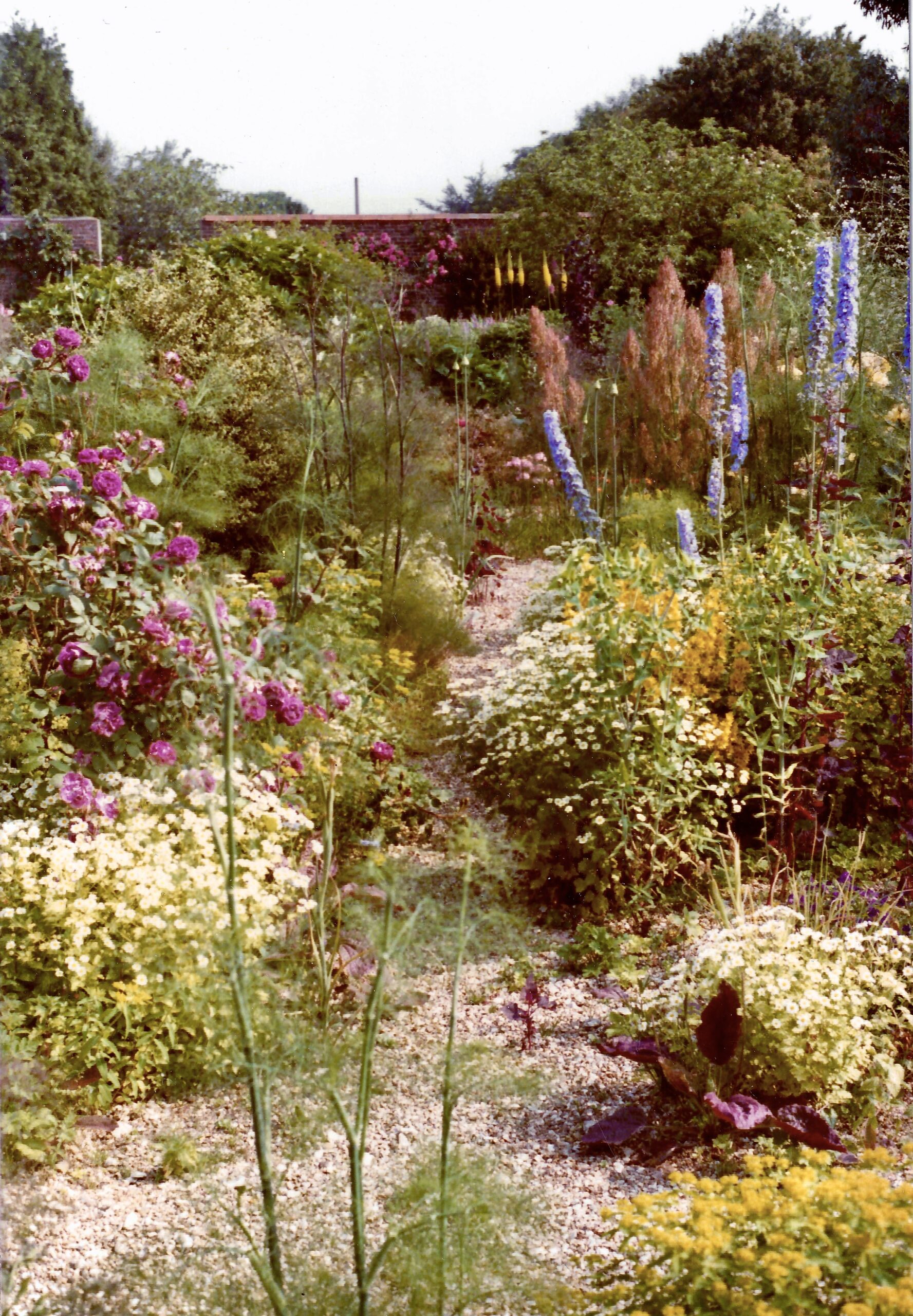
Mrs. Robinson’s first gravel garden was started in 1970 in the Walled Garden. This is how it appeared in 1979.
The four-acre West Sussex oasis, which has undergone an extended period of renovation, was started in the 1940s by Robinson whose extensive gravel gardens with a whole new approach to planting captivated Brookes when he first visited in 1973. Admiring Robinson’s widespread use of gravel and innovative naturalistic planting style, he later wrote that ‘to say that Denmans is a wild garden would be to paint the picture wrongly, yet it is managed along very natural lines. And this is what is unique; for it seems to pioneer a type of decorative gardening from which we all could learn.’
Seven years later, Brookes moved to Denmans Garden to take over its management and to start his own Clock House School of Garden Design, named after the old stable which he converted into his home and studio. In the following decades, he stylized the garden with bold lines and architectural plantings, melding his cutting-edge design vision with Robinson’s innovative gravel gardens and extensive plant palette. Rather than changing the garden, Brookes embraced Robinson’s achievement, integrating his own strong, curving lines punctuated with muscular architectural plantings and a coherent geometry, adding two ponds and touches of sculpture and topiary. The combination of their approaches serves to make Denmans Garden seem much larger than it is; a unique and tranquil garden that ‘works’ in all seasons.
Brookes and Robinson were ahead of their times in advocating a low-maintenance and sustainable approach to gardening that is in harmony with nature and sympathetic to the surrounding landscape and wildlife, concepts that are becoming increasingly urgent. This approach is reflected in Denmans Garden: Room Outside which is based on principles that can easily be applied at home, combining a simple yet bold design with environmentally sensitive and sustainable plantings selected for their texture, shape, colour, and form.
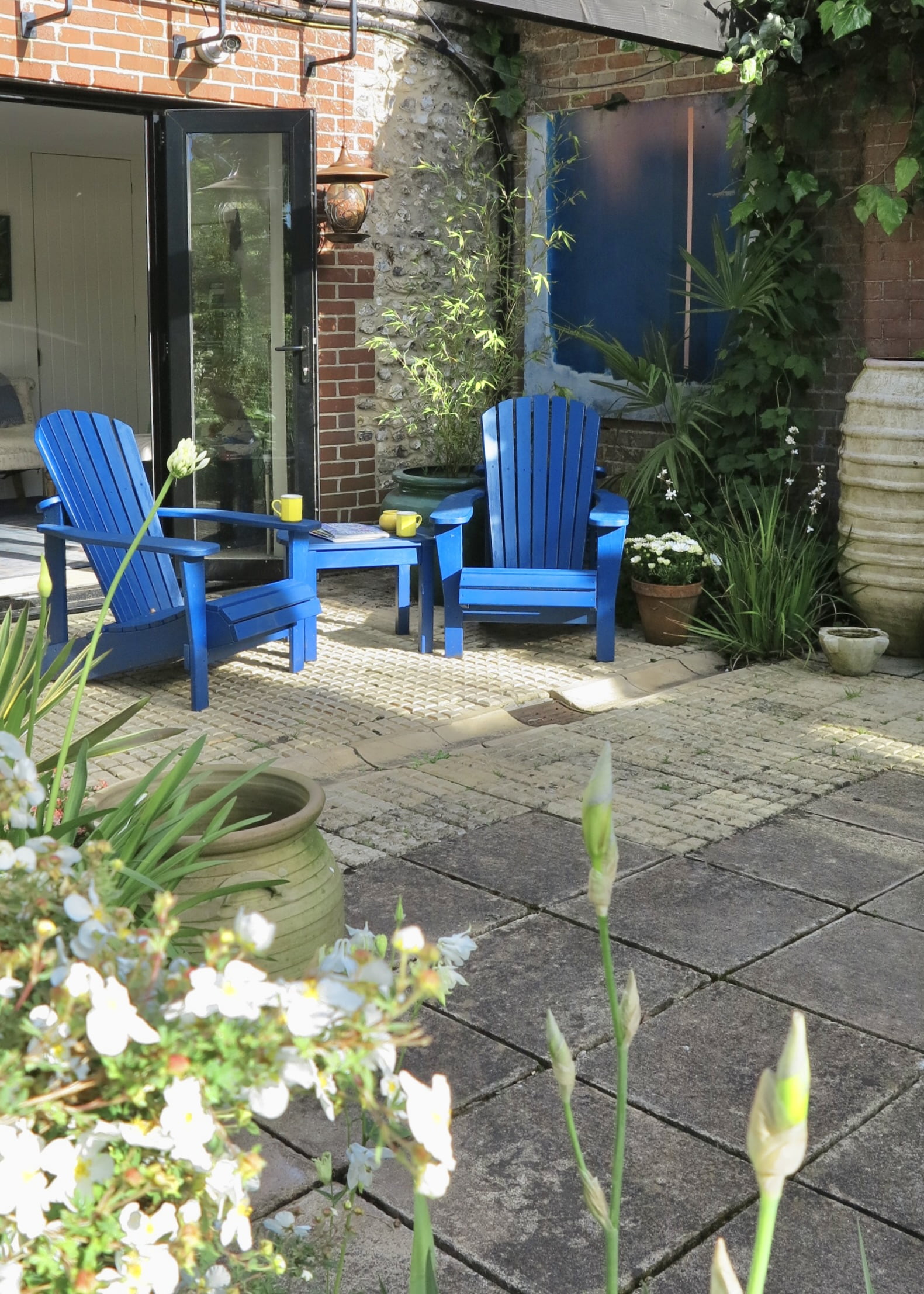 The Feature Garden will also include a specially commissioned painting of Clock House and its surrounding garden by Denmans Garden’s 2024 Artist-in-Residence Oscar Romp and a sculpture by Sussex-based contemporary sculptor Helen Solly, whose current exhibition ‘Garden Reflections’ at Denmans Garden showcases unique hand-made pieces inspired by the garden.
The Feature Garden will also include a specially commissioned painting of Clock House and its surrounding garden by Denmans Garden’s 2024 Artist-in-Residence Oscar Romp and a sculpture by Sussex-based contemporary sculptor Helen Solly, whose current exhibition ‘Garden Reflections’ at Denmans Garden showcases unique hand-made pieces inspired by the garden.
Robinson had a painterly aesthetic, referring to her garden as her ‘canvas’.The dry river beds she laid out were, in fact, a form of land art having been inspired by nature and built with natural materials and plants.
Brookes, a Modernist, was influenced by abstract painters like Piet Mondrian, and Ben Nicholsen and, like his mentor Sir Geoffrey Jellicoe, regarded garden design as an art form. Consistent with this artistic legacy, Denmans Garden runs a year-round programme of art exhibitions and artist residencies.
Denmans Garden: Room Outside is realised by Denmans Garden’s gardening team with support from its group of dedicated volunteers, as well as local growers, craftspeople, and makers who make up the vibrant and supportive community that has grown around the West Sussex Garden. Most of the materials used will be repurposed from Denmans Garden and returned to the garden at the end of the festival.
Gwendolyn van Paasschen, garden designer, writer and Chair of the John Brookes-Denmans Foundation, tells us more about Brookes’ ‘Room Outside’ concept here.
www.denmans.org @denmans_garden
For press queries:
Helena Zedig, MAP Strategic Communications helena@mapstrategic.co | 07803 596 587
Louise Campbell, Publicity & Marketing, Denmans Garden louise@denmans.org
NOTES TO EDITORS
About Denmans Garden
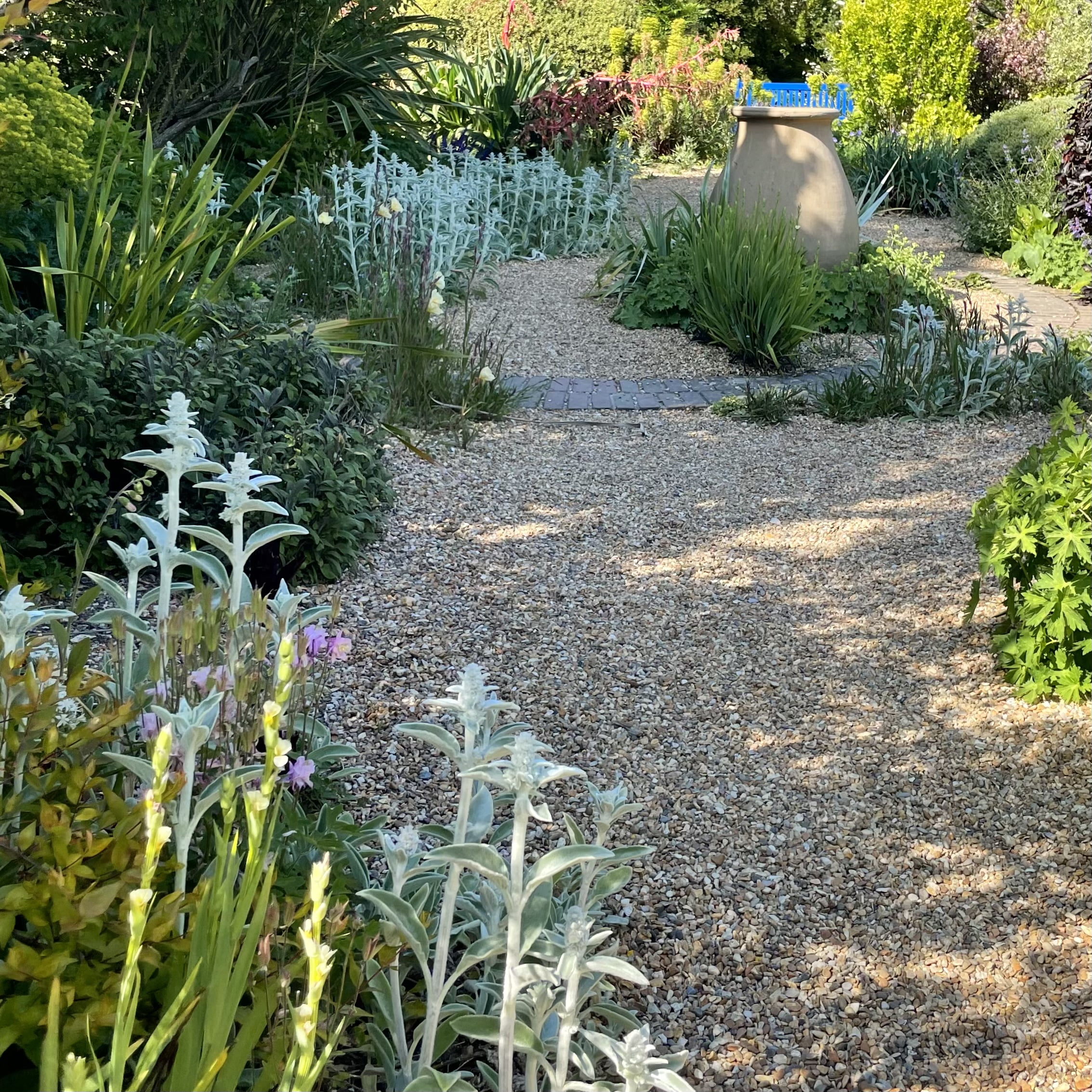 A unique post-war garden in West Sussex, Denmans Garden was begun in the late 1940s by gravel garden pioneer Joyce Robinson and became the home of influential landscape designer, John Brookes MBE in 1980. It is renowned for its diverse plantings and curvilinear layout comprised of distinct spaces linked by meandering paths of gravel and mown lawn through rough grass; its horticultural diversity; and the gravel gardens and dry riverbeds that Robinson created and Brookes expanded and stylized between 1980-2018. Ahead of its time, Denmans Garden is where cutting-edge design meets sophisticated horticultural style.
A unique post-war garden in West Sussex, Denmans Garden was begun in the late 1940s by gravel garden pioneer Joyce Robinson and became the home of influential landscape designer, John Brookes MBE in 1980. It is renowned for its diverse plantings and curvilinear layout comprised of distinct spaces linked by meandering paths of gravel and mown lawn through rough grass; its horticultural diversity; and the gravel gardens and dry riverbeds that Robinson created and Brookes expanded and stylized between 1980-2018. Ahead of its time, Denmans Garden is where cutting-edge design meets sophisticated horticultural style.
The journey through Denmans Garden takes visitors across dry riverbeds, gravel gardens, a walled garden, a woodland, and ponds punctuated by Brookes’ iconic blue benches intended for contemplation and conversation. With no prescribed route through the garden, visitors wander at will, experiencing its different spaces.
Having undergone extensive restoration since 2018, Denmans Garden has won multiple awards, including RHS Regional Partner Garden of the Year (2021 and 2023), and Gold in the South & South East in Bloom competitions (2021- 2023). In 2020, along with 19 other post-war gardens, it was registered Grade II. The garden is managed with a sensitivity to the combined ethos of its two creators, including biodiversity and ecological considerations. The Denmans Garden visitor experience also includes Midpines Café, a gift shop, a plant centre featuring unusual plants, as well as a growing programme of year-round events – from exhibitions by Denmans Garden’s artists-in-residence to courses, workshops, talks and performances.
About Joyce Robinson (1903-1996)
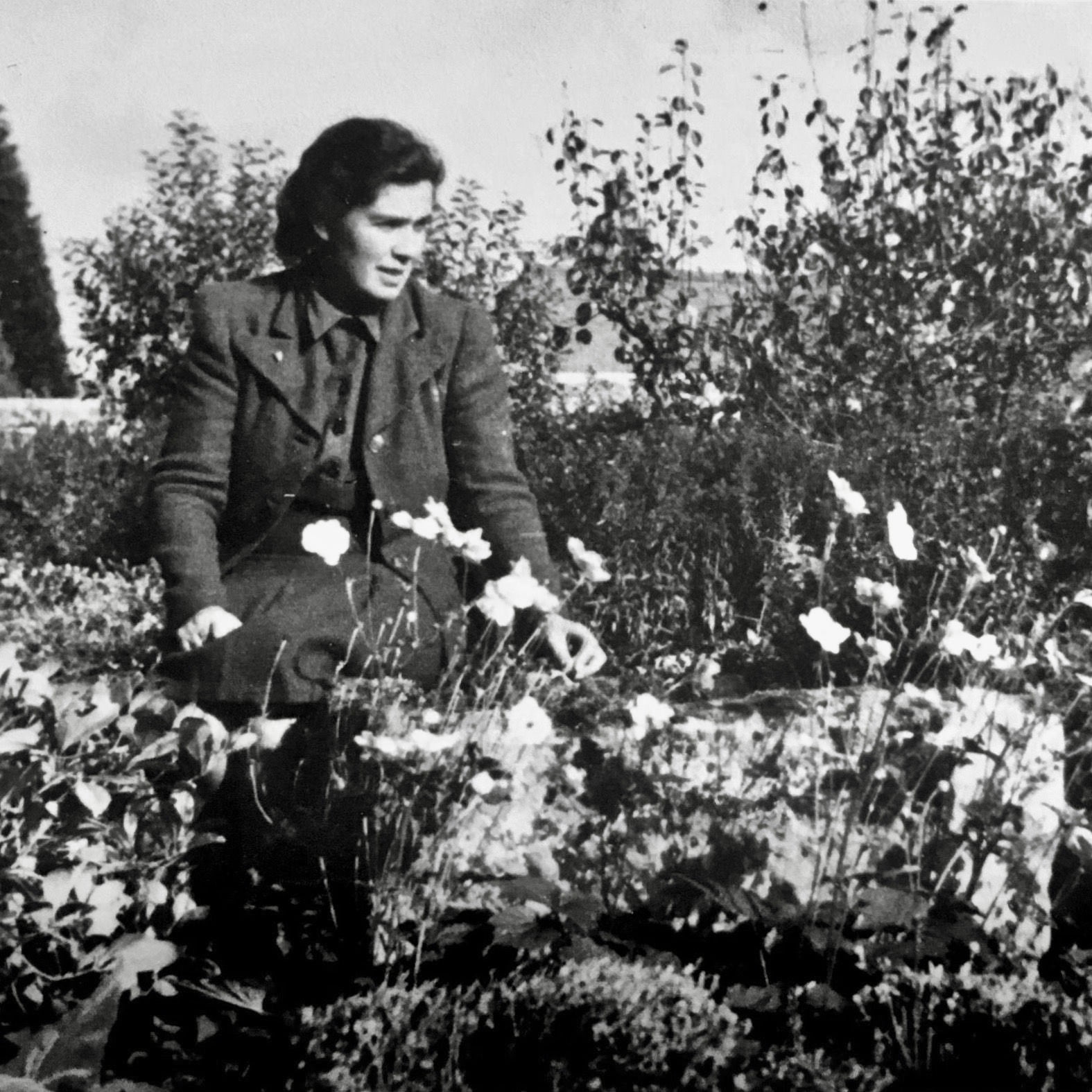 A self-taught horticulturist with a passion for plants and creating garden compositions, Joyce Hilda Robinson and her husband Hugh purchased what was then the neglected Westergate Estate in 1946. They renamed it ‘Denmans’ after Lord Thomas Denmans whose family owned the property in the late 1800s, and transformed it into a thriving market garden which supplied Covent Garden Market and local shops with produce and cut flowers. In 1952 she began the ornamental garden and eventually started writing for the West Sussex Gazette while developing relationships with notable horticulturists of the day. In 1970, inspired by a visit to Delos, she began gravel gardening on a large scale and planting in a naturalistic yet highly controlled manner that was intended to provide year-round interest. She referred to her planting style, which was inspired by nature and integrated exotic plants, as ‘Glorious Disarray’, the title of her 1990 book (Michael Joseph, London) about her experiences. She started her business, “Denmans Plants” in the early 1970s and in 1977 created two dry river beds inspired by the winterbourne rivers of the South Downs. Having opened the garden to charity in the early 1960s, she was asked to join the National Garden Scheme in 1967.
A self-taught horticulturist with a passion for plants and creating garden compositions, Joyce Hilda Robinson and her husband Hugh purchased what was then the neglected Westergate Estate in 1946. They renamed it ‘Denmans’ after Lord Thomas Denmans whose family owned the property in the late 1800s, and transformed it into a thriving market garden which supplied Covent Garden Market and local shops with produce and cut flowers. In 1952 she began the ornamental garden and eventually started writing for the West Sussex Gazette while developing relationships with notable horticulturists of the day. In 1970, inspired by a visit to Delos, she began gravel gardening on a large scale and planting in a naturalistic yet highly controlled manner that was intended to provide year-round interest. She referred to her planting style, which was inspired by nature and integrated exotic plants, as ‘Glorious Disarray’, the title of her 1990 book (Michael Joseph, London) about her experiences. She started her business, “Denmans Plants” in the early 1970s and in 1977 created two dry river beds inspired by the winterbourne rivers of the South Downs. Having opened the garden to charity in the early 1960s, she was asked to join the National Garden Scheme in 1967.
She retired in 1985, handing full management of the garden over to John Brookes, and continued to live at Denmans Garden until her death in 1996.
About John Brookes MBE (1933-2018)
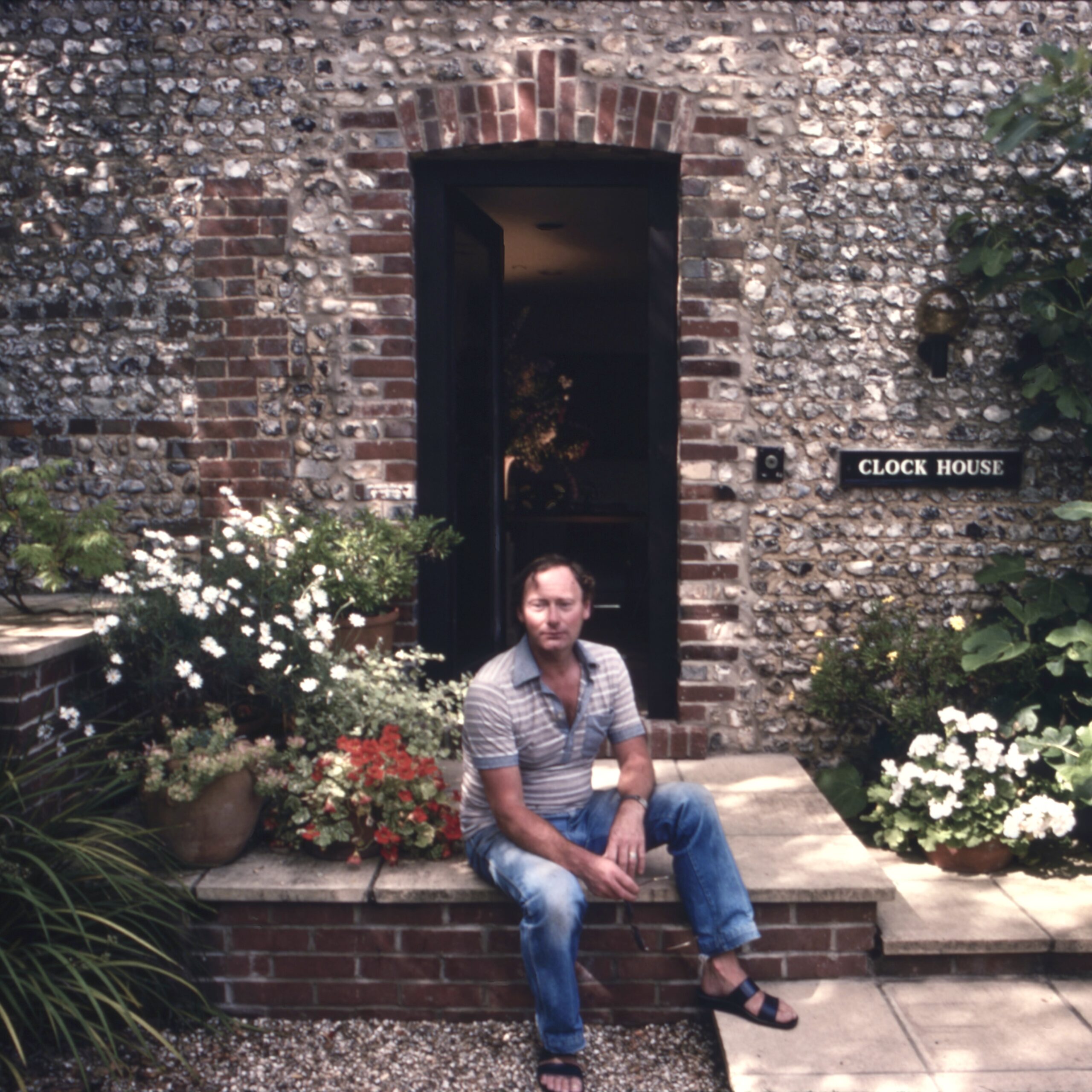 A Modernist dubbed ‘The Man who Made the Modern Garden’, John Brookes MBE started his career in the landscape architecture offices of Brenda Colvin and Dame Sylvia Crow, followed by a four-year stint at Architectural Design Magazine. In 1962, Brookes became the first independent designer to show a garden at the Chelsea Flower Show and the first to exhibit a garden as an extension of a house, a novel concept at the time. Controversial as it was (the RHS now credits this garden as the one that brought Modernism to Chelsea), he won the Silver Flora medal. In the 1960s, Brookes subsequently designed important gardens such as his 1964 courtyard garden for Penguin books (now lost) and others which ultimately challenged the British concept of the garden. He believed gardens should be about the people who lived in them, beautifully designed, affordable, and easily maintained; refuges from the modern lifestyle.
A Modernist dubbed ‘The Man who Made the Modern Garden’, John Brookes MBE started his career in the landscape architecture offices of Brenda Colvin and Dame Sylvia Crow, followed by a four-year stint at Architectural Design Magazine. In 1962, Brookes became the first independent designer to show a garden at the Chelsea Flower Show and the first to exhibit a garden as an extension of a house, a novel concept at the time. Controversial as it was (the RHS now credits this garden as the one that brought Modernism to Chelsea), he won the Silver Flora medal. In the 1960s, Brookes subsequently designed important gardens such as his 1964 courtyard garden for Penguin books (now lost) and others which ultimately challenged the British concept of the garden. He believed gardens should be about the people who lived in them, beautifully designed, affordable, and easily maintained; refuges from the modern lifestyle.
His first book ‘Room Outside’ (1969, Thames & Hudson) laid out the basics of garden design and construction to an audience that ranged from homeowners to nascent garden designers and architects. Brookes went on to publish over 25 books, many translated into other languages. He designed gardens around the world, ranging from small private gardens to public gardens such as the English Garden at the Chicago Botanic Garden and RHS Partner Garden Barakura English Garden near Kyoto, and taught and lectured from Japan to South and North America, Europe, Russia, and at home. He served as chair of the Society of Garden Designers from 1996-99 and was awarded the SGD lifetime achievement award in 2017. In addition to many other awards, he was awarded an MBE for garden design and services to horticulture in 2004.
He discovered Denmans Garden through the National Garden Scheme in 1973 and, in 1980, after renovating the stable, moved there to start his Clock House School of Garden design and take over management of the garden which he purchased in 1997 with a business partner. He lived at Denmans Garden until his death in 2018.
The John Brookes-Denmans Foundation
The John Brookes-Denmans Foundation promotes and disseminates the John Brookes MBE design legacy to enhance the experience of landscape and garden design students and professionals, landscape contractors, homeowners, and gardeners. The Foundation works to safeguard Denmans Garden’s place in the history of gardens and garden design, while developing it as a centre for landscape and garden design excellence. Central to its mission is a focus on accessible and sustainable design and planting, drawing on the visionary approach taken by John Brookes MBE together with horticulturist Joyce Robinson – a pioneer in gravel gardening – when they created Denmans Garden between 1947 and 1985.

